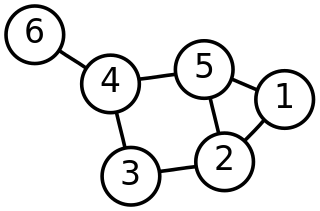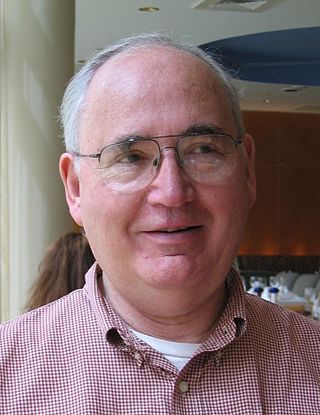Related Research Articles

Discrete mathematics is the study of mathematical structures that can be considered "discrete" rather than "continuous". Objects studied in discrete mathematics include integers, graphs, and statements in logic. By contrast, discrete mathematics excludes topics in "continuous mathematics" such as real numbers, calculus or Euclidean geometry. Discrete objects can often be enumerated by integers; more formally, discrete mathematics has been characterized as the branch of mathematics dealing with countable sets. However, there is no exact definition of the term "discrete mathematics".

In mathematics, a filter or order filter is a special subset of a partially ordered set (poset), describing "large" or "eventual" elements. Filters appear in order and lattice theory, but also topology, whence they originate. The notion dual to a filter is an order ideal.

In mathematical analysis and related areas of mathematics, a set is called bounded if all of its points are within a certain distance of each other. Conversely, a set which is not bounded is called unbounded. The word "bounded" makes no sense in a general topological space without a corresponding metric.
In mathematics, especially in order theory, a Galois connection is a particular correspondence (typically) between two partially ordered sets (posets). Galois connections find applications in various mathematical theories. They generalize the fundamental theorem of Galois theory about the correspondence between subgroups and subfields, discovered by the French mathematician Évariste Galois.

Dana Stewart Scott is an American logician who is the emeritus Hillman University Professor of Computer Science, Philosophy, and Mathematical Logic at Carnegie Mellon University; he is now retired and lives in Berkeley, California. His work on automata theory earned him the Turing Award in 1976, while his collaborative work with Christopher Strachey in the 1970s laid the foundations of modern approaches to the semantics of programming languages. He has also worked on modal logic, topology, and category theory.
Domain theory is a branch of mathematics that studies special kinds of partially ordered sets (posets) commonly called domains. Consequently, domain theory can be considered as a branch of order theory. The field has major applications in computer science, where it is used to specify denotational semantics, especially for functional programming languages. Domain theory formalizes the intuitive ideas of approximation and convergence in a very general way and is closely related to topology.
Order theory is a branch of mathematics that investigates the intuitive notion of order using binary relations. It provides a formal framework for describing statements such as "this is less than that" or "this precedes that". This article introduces the field and provides basic definitions. A list of order-theoretic terms can be found in the order theory glossary.
This is a glossary of some terms used in various branches of mathematics that are related to the fields of order, lattice, and domain theory. Note that there is a structured list of order topics available as well. Other helpful resources might be the following overview articles:
In mathematics, a closure operator on a set S is a function from the power set of S to itself that satisfies the following conditions for all sets
In mathematical order theory, an ideal is a special subset of a partially ordered set (poset). Although this term historically was derived from the notion of a ring ideal of abstract algebra, it has subsequently been generalized to a different notion. Ideals are of great importance for many constructions in order and lattice theory.
In mathematics, the phrase complete partial order is variously used to refer to at least three similar, but distinct, classes of partially ordered sets, characterized by particular completeness properties. Complete partial orders play a central role in theoretical computer science: in denotational semantics and domain theory.
In mathematics, especially in order theory, a complete Heyting algebra is a Heyting algebra that is complete as a lattice. Complete Heyting algebras are the objects of three different categories; the category CHey, the category Loc of locales, and its opposite, the category Frm of frames. Although these three categories contain the same objects, they differ in their morphisms, and thus get distinct names. Only the morphisms of CHey are homomorphisms of complete Heyting algebras.
In the mathematical area of order theory, the compact elements or finite elements of a partially ordered set are those elements that cannot be subsumed by a supremum of any non-empty directed set that does not already contain members above the compact element. This notion of compactness simultaneously generalizes the notions of finite sets in set theory, compact sets in topology, and finitely generated modules in algebra.
In the mathematical fields of order and domain theory, a Scott domain is an algebraic, bounded-complete and directed-complete partial order (dcpo). They are named in honour of Dana S. Scott, who was the first to study these structures at the advent of domain theory. Scott domains are very closely related to algebraic lattices, being different only in possibly lacking a greatest element. They are also closely related to Scott information systems, which constitute a "syntactic" representation of Scott domains.
In mathematics, given two partially ordered sets P and Q, a function f: P → Q between them is Scott-continuous if it preserves all directed suprema. That is, for every directed subset D of P with supremum in P, its image has a supremum in Q, and that supremum is the image of the supremum of D, i.e. , where is the directed join. When is the poset of truth values, i.e. Sierpiński space, then Scott-continuous functions are characteristic functions of open sets, and thus Sierpiński space is the classifying space for open sets.
In mathematics, the upper topology on a partially ordered set X is the coarsest topology in which the closure of a singleton is the order section for each If is a partial order, the upper topology is the least order consistent topology in which all open sets are up-sets. However, not all up-sets must necessarily be open sets. The lower topology induced by the preorder is defined similarly in terms of the down-sets. The preorder inducing the upper topology is its specialization preorder, but the specialization preorder of the lower topology is opposite to the inducing preorder.

Steve Vickers is a British mathematician and computer scientist. In the early 1980s, he wrote ROM firmware and manuals for three home computers, the ZX81, ZX Spectrum, and Jupiter Ace. The latter was produced by Jupiter Cantab, a short-lived company Vickers formed together with Richard Altwasser, after the two had left Sinclair Research. Since the late 1980s, Vickers has been an academic in the field of geometric logic, writing over 30 papers in scholarly journals on mathematical aspects of computer science. His book Topology via Logic has been influential over a range of fields. In October 2018, he retired as senior lecturer at the University of Birmingham. As announced on his university homepage, he continues to supervise PhD students at the university and focus on his research.
Michael Ezra Saks is an American mathematician. He is currently the Department Chair of the Mathematics Department at Rutgers University (2017–) and from 2006 until 2010 was director of the Mathematics Graduate Program at Rutgers University. Saks received his Ph.D. from the Massachusetts Institute of Technology in 1980 after completing his dissertation titled Duality Properties of Finite Set Systems under his advisor Daniel J. Kleitman.
In topology, a branch of mathematics, a formal ball is an extension of the notion of ball to allow unbounded and negative radius. The concept of formal ball was introduced by Weihrauch and Schreiber in 1981 and the negative radius case by Tsuiki and Hattori in 2008.
References
- G. Gierz, K. H. Hofmann, K. Keimel, J. D. Lawson, M. Mislove, D. S. Scott (2003), Continuous Lattices and Domains, Encyclopedia of Mathematics and its Applications, Cambridge University Press. ISBN 0-521-80338-1